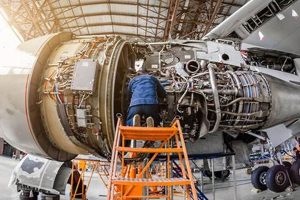Materials engineered through the combination of two or more distinct components, resulting in properties superior to those of the individual constituents, are increasingly prevalent in airframe and spacecraft construction. This approach allows for the creation of structures that are both lightweight and exceptionally strong, crucial for efficient and reliable operation in flight. A common example is the utilization of carbon fiber reinforced polymers in aircraft wings and fuselages, offering a high strength-to-weight ratio.
The application of these advanced materials offers significant advantages to the field. Weight reduction translates directly into improved fuel efficiency, longer flight ranges, and increased payload capacity. Furthermore, enhanced resistance to corrosion and fatigue leads to extended service life and reduced maintenance requirements. Historically, the adoption of these materials has revolutionized aircraft design, enabling the creation of more aerodynamic and fuel-efficient vehicles. They also contribute to improved passenger comfort through vibration damping and noise reduction.
The following sections will delve into specific applications, manufacturing techniques, material selection criteria, and future trends associated with the implementation of these advanced materials in the construction and maintenance of aircraft and spacecraft. Considerations will include cost-effectiveness, environmental impact, and the ongoing development of novel material systems designed to meet the evolving demands of air and space travel.
Guidance on the Use of Advanced Materials in Flight Vehicle Construction
The following guidelines address critical considerations for engineers and designers involved in the application of advanced material systems in the manufacturing and maintenance of airframes and spacecraft.
Tip 1: Rigorous Material Characterization: Comprehensive testing is essential to determine the precise mechanical, thermal, and chemical properties of each material. This data forms the foundation for accurate structural analysis and ensures predictable performance under operational conditions. For example, tensile strength, fatigue resistance, and thermal expansion coefficients must be meticulously documented.
Tip 2: Optimized Fiber Orientation: The alignment of reinforcing fibers within the matrix significantly impacts the overall strength and stiffness of the component. Careful consideration must be given to the anticipated load paths and stress concentrations to optimize fiber orientation for maximum structural integrity. Finite element analysis can assist in determining the most effective fiber architecture.
Tip 3: Effective Cure Cycle Management: Precise control over temperature and pressure during the curing process is crucial for achieving the desired material properties and minimizing voids or defects. Deviations from the prescribed cure cycle can compromise the structural integrity and long-term durability of the component. Automated monitoring systems and calibrated equipment are essential.
Tip 4: Non-Destructive Inspection (NDI) Implementation: Regular NDI is mandatory to detect any internal flaws, delaminations, or other defects that may arise during manufacturing or service. Techniques such as ultrasonic testing, radiography, and thermography can be employed to assess the structural health of the component without causing damage. Establish baseline data and trend analysis for predictive maintenance.
Tip 5: Proper Surface Preparation for Bonding: Adhesion between these materials and other components requires meticulous surface preparation. Cleaning, etching, and priming protocols must be strictly adhered to in order to achieve a strong and durable bond. Surface energy measurements can verify the effectiveness of the surface treatment.
Tip 6: Environmental Protection Strategies: Exposure to harsh environmental conditions, such as ultraviolet radiation, humidity, and temperature extremes, can degrade material properties over time. Protective coatings, sealants, and design features should be incorporated to mitigate environmental effects and prolong service life.
Tip 7: Repair Methodology Development: Comprehensive repair procedures are necessary to address any damage that may occur during service. These procedures must be validated through rigorous testing and should address issues such as material compatibility, bond strength, and long-term durability. Document all repairs thoroughly.
Adherence to these guidelines promotes the safe and reliable application of these advanced materials, maximizing their benefits and minimizing potential risks. Diligence in material selection, manufacturing process control, and inspection procedures is paramount.
The subsequent discussions will delve into the implications of material innovations on the future of aviation and space exploration, including emerging technologies and research directions.
1. Weight Reduction
The imperative for weight reduction in the aerospace sector is a fundamental driver in the adoption of advanced material systems. Decreasing the mass of an aircraft or spacecraft directly correlates with improved fuel efficiency, enhanced payload capacity, and reduced operational costs. The strategic application of composite materials offers a pathway to achieving significant weight savings without compromising structural integrity.
- Improved Fuel Efficiency
Reduced weight directly translates into lower fuel consumption. Less energy is required to propel a lighter aircraft, leading to substantial cost savings over the lifespan of the vehicle. This effect is magnified on long-haul flights and in high-performance aircraft, where fuel constitutes a significant portion of the operating expenses. The lower fuel consumption also results in reduced emissions, aligning with environmental sustainability goals.
- Increased Payload Capacity
For a given aircraft design, decreasing the structural weight frees up additional capacity for passengers, cargo, or mission-specific equipment. This is particularly critical in commercial aviation, where maximizing revenue per flight is a primary objective. In the context of spacecraft, weight reduction is even more crucial due to the exponential costs associated with launching mass into orbit.
- Enhanced Performance Metrics
Lighter aircraft exhibit improved maneuverability, acceleration, and climb rates. The enhanced power-to-weight ratio contributes to superior overall performance, making these materials invaluable in military aircraft and high-speed civil transport designs. Responsiveness and agility are critical factors in these applications, necessitating the minimization of structural mass.
- Extended Operational Range
Reduced weight allows an aircraft to travel greater distances with the same amount of fuel. This extended range is beneficial for both commercial airlines, enabling non-stop flights between distant destinations, and for military applications, where long-range reconnaissance and deployment are required. The increased range translates to greater operational flexibility and strategic advantages.
The benefits derived from weight reduction are central to the value proposition of advanced composite materials in the aerospace domain. These advantages drive continued research and development efforts focused on creating even lighter and stronger material systems, further optimizing aircraft performance and operational efficiency. The economic and performance benefits of these materials are compelling factors in the ongoing evolution of aerospace engineering.
2. Structural Integrity
Structural integrity is a paramount consideration in the aerospace industry, inextricably linked to the successful application of advanced material systems. Composites offer the potential for significant weight reduction, but this benefit cannot come at the expense of safety or reliability. Therefore, ensuring the structural integrity of composite components is critical for the safe operation of aircraft and spacecraft. The design, manufacturing, and maintenance processes must rigorously address potential failure modes and ensure that the structure can withstand the stresses and strains encountered during flight.
The inherent anisotropy of certain composites, where material properties differ depending on direction, necessitates sophisticated design and analysis techniques. Finite element analysis, coupled with extensive physical testing, is used to predict structural behavior under various loading conditions. Furthermore, manufacturing defects, such as voids or delaminations, can significantly reduce structural strength. Non-destructive inspection methods are therefore essential for identifying and characterizing any flaws that may compromise the integrity of the component. The Airbus A350, for example, incorporates a significant amount of carbon fiber reinforced polymer in its airframe, relying on advanced manufacturing and inspection techniques to ensure structural performance throughout its service life.
In conclusion, structural integrity is an indispensable aspect of the implementation of advanced material systems in aerospace applications. It demands rigorous design, manufacturing, and inspection procedures. While composites offer numerous advantages, their safe and effective utilization relies on a thorough understanding of material behavior and a commitment to maintaining the highest standards of engineering practice. The ongoing development of improved manufacturing techniques and advanced non-destructive testing methods will continue to enhance the structural integrity and reliability of composite components in the aerospace industry.
3. Corrosion Resistance
The susceptibility of traditional metallic materials to corrosion presents a significant challenge in the aerospace industry, leading to increased maintenance costs and potential structural failures. The inherent corrosion resistance of many advanced material systems provides a compelling advantage, contributing to enhanced aircraft lifespan and reduced operational expenses.
- Elimination of Corrosion-Related Maintenance
Unlike aluminum alloys, which are prone to galvanic corrosion and require frequent inspection and treatment, many polymers are inherently resistant to environmental degradation. This minimizes the need for costly and time-consuming maintenance procedures, reducing aircraft downtime and lifecycle costs. Aircraft utilizing a high percentage of these materials experience significantly reduced corrosion-related maintenance requirements.
- Resistance to Chemical Exposure
Aircraft structures are routinely exposed to a variety of chemicals, including de-icing fluids, hydraulic oils, and cleaning solvents. Certain classes of polymers exhibit excellent chemical resistance, preventing degradation and maintaining structural integrity in harsh operating environments. This characteristic is particularly important in areas such as fuel tanks and engine nacelles.
- Reduced Weight through Elimination of Corrosion Protection
Traditional aluminum structures require the application of protective coatings and corrosion inhibitors, adding weight to the aircraft. The use of inherently corrosion-resistant composites eliminates the need for these additional measures, contributing to overall weight reduction and improved fuel efficiency. This is a critical factor in the design of modern aircraft.
- Enhanced Durability in Marine Environments
Aircraft operating in coastal regions are exposed to saltwater, which is highly corrosive to many metals. The corrosion resistance of polymers makes them particularly well-suited for these environments, extending the lifespan of aircraft and reducing the need for frequent repairs. The use of polymers in naval aircraft, for example, is driven in part by this consideration.
The integration of materials possessing high resistance to degradation into aircraft design translates directly into significant cost savings and enhanced safety. The reduced maintenance burden and improved durability associated with these materials are key drivers in their continued adoption within the aerospace industry, offering a viable alternative to traditional metallic structures in demanding operational environments.
4. Design Flexibility
The ability to tailor the properties and shapes of aerospace components is significantly enhanced by the utilization of advanced material systems. Unlike traditional metallic materials with fixed characteristics, polymers allow engineers to optimize the structure for specific performance requirements. This inherent design flexibility enables the creation of complex geometries, aerodynamic profiles, and integrated functionalities that would be challenging or impossible to achieve with conventional materials. This impacts both the structural efficiency and the overall performance of the aircraft or spacecraft.
Examples of this flexibility are evident in modern aircraft wings, where complex curves and airfoil shapes are readily manufactured using automated fiber placement techniques. Furthermore, features such as integrated stiffeners and aerodynamic control surfaces can be seamlessly incorporated into the composite structure, reducing the number of fasteners and simplifying assembly. The Boeing 787 Dreamliner is a prime example, showcasing the extensive use of advanced material systems to achieve an aerodynamically efficient and structurally optimized airframe. Additionally, the design of composite spacecraft components allows for integration of thermal protection systems and structural elements into a single, tailored component.
In summary, the design freedom afforded by composites is a major driver of their increasing adoption in the aerospace sector. It enables engineers to create lighter, stronger, and more efficient aircraft and spacecraft, pushing the boundaries of aerodynamic performance and structural innovation. The challenges lie in developing advanced design tools and manufacturing processes that can fully exploit the potential of these materials, as well as ensuring the long-term durability and reliability of complex composite structures.
5. Fuel Efficiency
The correlation between fuel efficiency and the application of advanced material systems is a defining characteristic of modern aerospace engineering. Weight reduction, a direct consequence of using high strength-to-weight ratio materials, is a primary driver in minimizing fuel consumption in aircraft and spacecraft. Less energy is required to propel a lighter structure, leading to significant cost savings and reduced environmental impact. The relationship is direct: as the proportion of these advanced material systems in an aircraft’s construction increases, its fuel efficiency generally improves, assuming all other factors remain constant. Understanding this dependency is critical for designing cost-effective and environmentally conscious aircraft.
The implementation of such systems on aircraft like the Boeing 787 Dreamliner exemplifies this principle. By utilizing carbon fiber reinforced polymers for a substantial portion of its airframe, the 787 achieves significantly improved fuel efficiency compared to aircraft constructed primarily from aluminum alloys. This translates into lower operating costs for airlines and reduced carbon emissions per passenger mile. Similar applications can be observed in spacecraft design, where minimizing weight is crucial due to the high costs associated with launching mass into orbit. The reduced structural weight allows for either a larger payload capacity or a smaller launch vehicle, both contributing to improved mission economics.
In conclusion, the impact of advanced material systems on fuel efficiency is a cornerstone of contemporary aerospace design. The continuous development of lighter and stronger materials, coupled with advanced manufacturing techniques, will further enhance fuel economy and reduce the environmental footprint of air and space travel. Future challenges involve balancing the cost of these materials with the projected fuel savings, as well as addressing issues related to end-of-life disposal and recyclability to ensure long-term sustainability. The pursuit of fuel-efficient aircraft and spacecraft will continue to drive innovation in material science and engineering.
6. Manufacturing Processes
The effectiveness and cost-efficiency of integrating advanced material systems into flight vehicle structures are directly dependent on the employed manufacturing processes. These processes dictate the final material properties, structural integrity, and overall performance of the aerospace component. Optimized manufacturing techniques are essential for realizing the full potential of these materials and ensuring their reliable operation in demanding aerospace environments. Careful selection and control of these processes are thus paramount for the successful adoption of such systems within the industry.
- Automated Fiber Placement (AFP)
AFP involves the precise deposition of continuous fiber tows onto a mold surface, enabling the creation of complex shapes with tailored fiber orientations. This automation reduces labor costs and improves consistency compared to manual lay-up methods. AFP is used in the manufacturing of large composite structures such as aircraft wings and fuselages, allowing for optimized material distribution and enhanced structural performance. The process also minimizes material waste and reduces cycle times, contributing to cost-effectiveness.
- Resin Transfer Molding (RTM)
RTM is a closed-mold process in which dry fiber preforms are placed into a mold cavity, and resin is then injected under pressure. This technique is suitable for producing complex, near-net-shape parts with good surface finish and dimensional accuracy. RTM is used in the manufacture of aircraft interior components, control surfaces, and structural parts. The closed-mold nature of the process minimizes volatile emissions and ensures consistent resin impregnation, leading to improved material properties.
- Autoclave Curing
Autoclave curing involves the application of heat and pressure within a sealed chamber to consolidate and cure the composite material. This process ensures proper fiber wet-out, reduces void content, and enhances interlaminar bond strength. Autoclave curing is widely used in the aerospace industry for manufacturing high-performance structural components, such as aircraft wings and fuselage panels. The precise control of temperature and pressure during the cure cycle is critical for achieving optimal material properties and structural integrity.
- Non-Destructive Inspection (NDI)
NDI techniques are integral to the manufacturing process, providing a means to detect internal flaws or defects in composite components without causing damage. Methods such as ultrasonic testing, radiography, and thermography are used to identify voids, delaminations, and other anomalies that may compromise structural integrity. NDI is performed at various stages of the manufacturing process to ensure quality control and compliance with stringent aerospace standards. The data obtained from NDI is used to assess component acceptability and to identify areas requiring repair or rework.
These processes, combined with ongoing advancements in automation and process control, are enabling the cost-effective manufacturing of high-performance composite structures for aerospace applications. Future trends include the development of out-of-autoclave curing techniques and the integration of advanced sensors for real-time process monitoring, further enhancing the efficiency and reliability of manufacturing processes. The selection and optimization of these processes are crucial for realizing the full potential of advanced material systems in flight vehicle construction and maintenance.
7. Lifecycle Costs
The economic viability of integrating advanced material systems into aerospace applications is inextricably linked to a comprehensive evaluation of lifecycle costs. This encompasses not only the initial acquisition expense but also the long-term operational and maintenance expenditures associated with the component throughout its service life. A thorough understanding of these costs is essential for making informed decisions regarding material selection and design choices.
- Initial Material and Manufacturing Costs
The upfront cost of materials and manufacturing processes for composite components can often be higher than traditional metallic counterparts. The raw materials, such as carbon fiber and specialized resins, can be expensive. Furthermore, the manufacturing processes, which may involve specialized equipment and skilled labor, can contribute significantly to the initial cost. However, these higher upfront costs must be balanced against potential long-term savings realized through reduced weight, improved fuel efficiency, and decreased maintenance requirements.
- Maintenance and Repair Costs
While many systems offer superior corrosion resistance compared to metals, they are not immune to damage. Repairing composite structures can be complex and require specialized expertise and equipment. However, the reduced frequency of corrosion-related maintenance and the potential for simplified repairs in certain cases can offset these higher repair costs. Predictive maintenance strategies, based on non-destructive inspection techniques, can also help to minimize unexpected downtime and associated repair expenses.
- Fuel Efficiency and Operational Costs
One of the primary drivers for using these systems is the potential for weight reduction, leading to improved fuel efficiency. The savings in fuel costs over the operational life of an aircraft can be substantial, often dwarfing the initial material and manufacturing expenses. Furthermore, reduced weight can also translate into increased payload capacity, generating additional revenue for airlines. These operational benefits are a crucial consideration in the lifecycle cost analysis.
- End-of-Life Disposal and Recycling Costs
The end-of-life disposal of composite materials presents a growing challenge. Unlike metals, polymers are difficult to recycle using conventional methods. Landfilling is often the primary disposal route, raising environmental concerns. Emerging technologies, such as pyrolysis and chemical recycling, offer potential solutions for recovering valuable materials from waste components, but these processes are currently expensive and not widely available. The long-term environmental and economic costs associated with disposal and recycling must be factored into the lifecycle cost assessment.
A holistic evaluation of lifecycle costs, encompassing material selection, manufacturing, maintenance, operation, and end-of-life disposal, is crucial for making informed decisions regarding the use of advanced material systems in aerospace applications. The initial higher costs may be justified by the long-term benefits of improved fuel efficiency, reduced maintenance, and enhanced performance. However, a thorough analysis is necessary to ensure that the overall lifecycle costs are minimized, and that the economic and environmental benefits are fully realized.
Frequently Asked Questions
This section addresses common inquiries regarding the utilization of engineered material systems in the aerospace sector, providing concise and informative answers to key concerns.
Question 1: What specific advantages do these materials offer over traditional aluminum alloys in aircraft construction?
These materials provide a superior strength-to-weight ratio compared to aluminum alloys. This characteristic results in lighter aircraft structures, leading to improved fuel efficiency, increased payload capacity, and enhanced performance metrics. Furthermore, many formulations exhibit superior corrosion resistance, reducing maintenance requirements and extending service life.
Question 2: What are the primary challenges associated with manufacturing structures using these systems?
Manufacturing these structures often requires specialized equipment, skilled labor, and precise process control. The inherent anisotropy of certain composites necessitates sophisticated design and analysis techniques. Maintaining consistent quality and minimizing defects, such as voids or delaminations, also present significant challenges. Quality control through rigorous non-destructive inspection is essential.
Question 3: How are composite structures repaired after sustaining damage during service?
Repair procedures for these systems require specialized training and materials. Damage assessment is critical to determine the extent of the damage and the appropriate repair method. Repairs may involve patching, bonding, or replacement of the damaged section. All repairs must be performed in accordance with approved procedures and subjected to rigorous inspection to ensure structural integrity.
Question 4: What steps are being taken to address the environmental impact of composite material disposal?
The aerospace industry is actively pursuing sustainable solutions for the end-of-life disposal of these systems. Research efforts are focused on developing recycling technologies, such as pyrolysis and chemical recycling, to recover valuable materials from waste components. Design for recyclability is also being considered in the development of new systems to minimize environmental impact.
Question 5: How does the cost of these materials compare to traditional materials like aluminum or titanium?
The initial material and manufacturing costs of these advanced material systems can be higher than those of traditional metallic materials. However, the lifecycle cost benefits, including reduced fuel consumption and maintenance expenses, can often offset the higher upfront costs. A comprehensive lifecycle cost analysis is essential for evaluating the economic viability of composite structures.
Question 6: What are some emerging trends in the development and application of these systems in aerospace?
Emerging trends include the development of bio-based polymers, self-healing composites, and additive manufacturing techniques for creating complex aerospace components. Research is also focused on improving the damage tolerance and durability of composite structures, as well as reducing manufacturing costs through automation and process optimization. These advancements promise to further enhance the performance and sustainability of aircraft and spacecraft.
The information provided aims to clarify key aspects of integrating these advanced material systems into flight vehicle design and construction, highlighting both the benefits and challenges associated with their utilization.
Subsequent sections will explore future innovations and the ongoing evolution of material science in the aerospace field.
Conclusion
This exploration has underscored the pivotal role of composites in aerospace industry, detailing their influence on weight reduction, structural integrity, corrosion resistance, design flexibility, fuel efficiency, manufacturing processes, and lifecycle costs. The attributes of these materials have been demonstrated to drive innovation and efficiency across a spectrum of aerospace applications, from commercial airliners to spacecraft. The implementation of these materials involves careful consideration of material properties, manufacturing techniques, and long-term performance under demanding operational conditions.
The ongoing development and refinement of composites remain critical to the future of aerospace engineering. Continued research into novel material systems, advanced manufacturing processes, and sustainable disposal methods is essential to unlocking further performance gains and minimizing environmental impact. As the demands on aerospace vehicles continue to evolve, the strategic application of composites will undoubtedly play a central role in shaping the next generation of air and space transportation systems, ensuring enhanced performance, safety, and economic viability.







